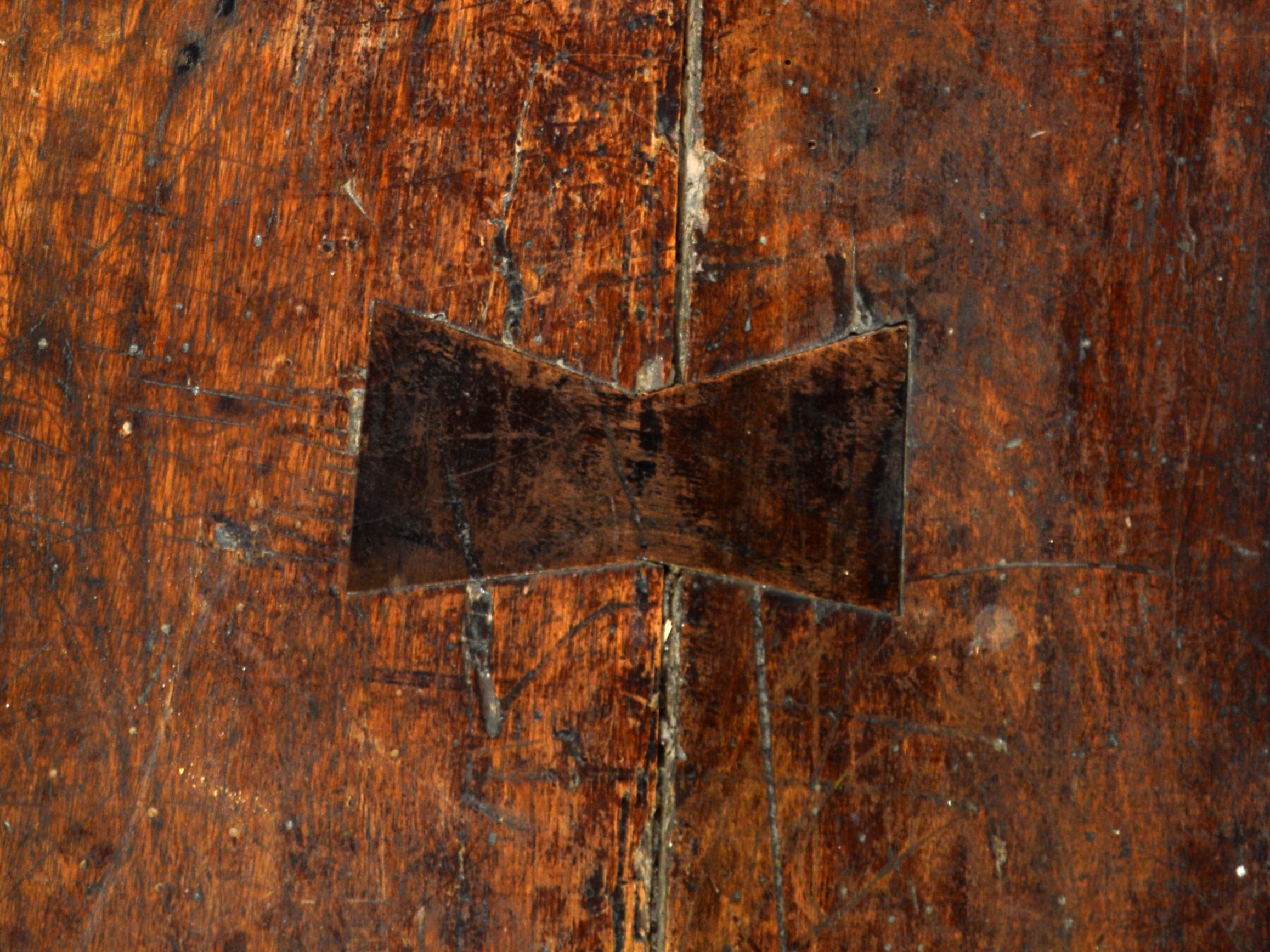Butterfly joint on:
[Wikipedia]
[Google]
[Amazon]
 A butterfly joint, also called a bow tie, dovetail key, Dutchman joint, or Nakashima joint, is a type of joint or inlay used to hold two or more pieces of woods together. These types of joints are mainly used for aesthetics, but they can also be used to reinforce cracks in pieces of wood, doors, picture frames, or drawers.
A dovetail key resembles two dovetails connected at the narrow part. A negative of the hole is cut out of the board the butterfly will be placed in and the butterfly is then fitted, keeping the joint together. The wood used for the butterfly is usually a contrasting wood, often walnut.
A butterfly joint, also called a bow tie, dovetail key, Dutchman joint, or Nakashima joint, is a type of joint or inlay used to hold two or more pieces of woods together. These types of joints are mainly used for aesthetics, but they can also be used to reinforce cracks in pieces of wood, doors, picture frames, or drawers.
A dovetail key resembles two dovetails connected at the narrow part. A negative of the hole is cut out of the board the butterfly will be placed in and the butterfly is then fitted, keeping the joint together. The wood used for the butterfly is usually a contrasting wood, often walnut.
A simple illustration of a butterfly joint
{{Woodworking Joinery Woodworking
History
Dutchman Joint
The term Dutchman is used when a patch or inlay covers a miss-cut or an imperfect piece of wood. A Dutchman can also cover a knot in the wood. A Dutchman can be wood or metal. The origin of the name is from San Francisco after the gold rush. All types of European craftsmen came to California to earn a living. The term Dutchman is slang given to the woodworking process of inserting patches. The term Dutchman has been found in the literature of John Russell Bartlett in the Dictionary of Americanisms and Edward H. Knight's American Mechanical Dictionary.Dovetail Key
In 1894,Jacques De Morgan
Jean-Jacques de Morgan (3 June 1857, Huisseau-sur-Cosson, Loir-et-Cher – 14 June 1924) was a French people, French mining engineer, geologist, and archaeologist. He was the director of antiquities in Khedivate of Egypt, Egypt during the 19th ...
discovered a group of boats at the pyramid complex of Khakaure Senwosret III at Dahshur
DahshurAlso transliterated ''Dahshour'' (in English often called ''Dashur'' ar, دهشور ' , ''Dahchur'') is a royal necropolis located in the desert on the west bank of the Nile approximately south of Cairo. It is known chiefly for several p ...
. Butterfly, or dovetail, joints were recorded as being used. Some archeologists argue that the dovetail joints were not originally fitted for the boats but were a modern replacement. The dovetail joints look to have been set into the faces of the planks to provide strength, after the excavation, so that it would not fall apart during transport. The craftsmanship of the joints was not what had been seen for the rest of the boats, they were also not fixed in place. Any type of force could cause the joint to fall out. There was also no mention of the joints in the original notes by Morgan taken when he first saw the boats. It is unlikely that if they were present, that he would have missed them. There have been reports of traditional Japanese boats using butterfly cramps but these were held in place by shellac.
Modern use
Contemporary decorative dovetail keys are commonly seen in and associated with the work ofGeorge Nakashima
George Katsutoshi Nakashima ( ja, 中島勝寿 ''Nakashima Katsutoshi'', May 24, 1905 – June 15, 1990) was an American woodworker, architect, and furniture maker who was one of the leading innovators of 20th century furniture design and a fathe ...
. George Nakashima, a Japanese-American woodworker, made the butterfly joint famous in the 1950s. He incorporated it into his nature-inspired woodworking pieces. Nakashima's idea was to not change the wood, only enhance its beauty.
How a Butterfly Joint is made
Butterfly joints are often made using abandsaw
A bandsaw (also written band saw) is a power saw with a long, sharp blade consisting of a continuous band of toothed metal stretched between two or more wheels to cut material. They are used principally in woodworking, metalworking, and lumb ...
. The piece of wood must be cut out, then sanded down to the proper size. The joint is then traced out onto another piece of wood. This piece of wood is what the end project will be made out of. Using a palm router or a chisel, the traced pattern is cut out of the wood. The joint is placed into the hole and glued down.
Notes
External links
A simple illustration of a butterfly joint
{{Woodworking Joinery Woodworking